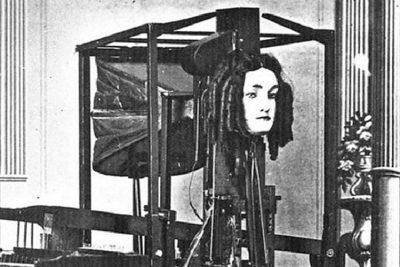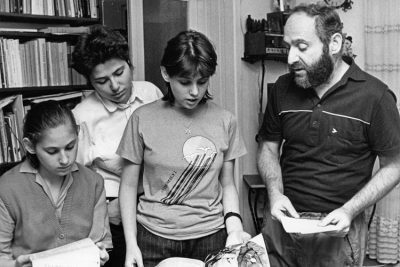Deep Blue – The IBM Chess Computer That Beat Chess Grand Master Garry Kasparov in 1997
Share

Garry Kasparov playing chess with multiple opponents, 1985. (GFHund / Wikimedia Commons)
Deep Blue was a chess-playing computer that IBM developed which became famous for playing a game against the reigning chess champion, Garry Kasparov, in 1996, and winning a match against him in 1997.
Origins of Deep Blue

An identical version of the Deep Blue at Computer History Museum, California. (Jim Gardner / Flickr)
In 1985, three computer science students at Carnegie Mellon University, Feng-hsiung Hsu, Thomas Anantharaman and Murray Campbell, built the chess-playing computer ChipTest. From this computer came a more improved version, Deep Thought. The project caught the attention of IBM and, after Feng-hsiung Hsu and Murray Campbell graduated, the company hired them to develop the Deep Thought project further. Thomas Anantharaman joined the company sometime later, but, after a short stint, left IBM to go work on Wall Street. IBM then roped in another programmer, Arthur Joseph Hoane, and their long-time employee, Jerry Brody, to join the team. Chess players Nick DeFirmian, Miguel Illescas Cordoba, and John Fedorowicz worked on the computer’s chess game. Randy Moulic and Chung Jen Tan were the team managers.
From Deep Thought, they developed Deep Blue, using the C programming language and the AIX operating system. IBM had a contest to come up with a suitable name for their chess computer and the name Deep Blue was the winner.
Deep Blue vs Garry Kasparov
On 10 February 1996, the reigning chess world champion, Garry Kasparov, won a chess match against Deep Blue. It was big news. Everyone thought it remarkable that a computer could play chess with anyone, never mind with a reigning world champion. The computer won one game in a six-game match. Of the remaining five games, Garry Kasparov won two and three ended in draws. Kasparov won the match as a result.
Nobody was surprised that the reigning world champion won. Not in the least the Grand Master himself. He had already announced to the world that there wasn’t a machine around that could beat him.
After the defeat, IBM took their computer back for a serious upgrade, contracted a chess player, Grandmaster Joel Benjamin, to help them refine Deep Blue’s opening book, and then contacted Garry Kasparov for a rematch the following year.
This time around, in May 1997, Deep Blue won the six-game encounter with a 3.5-2.5 win. Whether it won the match fair and square is another matter and a subject of controversy. Garry Kasparov didn’t think it had and accused Deep Blue and IBM of cheating.
According to Kasparov, the computer showed such unexpectedly creative and sophisticated moves in the second game that it was probable that, in violation of the rules, human chess players had dipped their oars into the chess game. IBM denied it had cheated and maintained that its computer program developers had only modified the program, which the game rules allowed them to do. The company refused to let Kasparov see their computer logs, however, and also turned down his demand for a rematch. Instead, they retired and dismantled their digital champion.
Deep Blue versus human intelligence
IBM continued to claim though that it was a historic man versus machine match that the machine ultimately won. Everyone doesn’t agree with this view. Several chess masters, who have studied the match, feel that Garry Kasparov wasn’t at his very best during the match and made a few regrettable opening mistakes. Also, he was placed at a disadvantage with the machine. Deep Blue’s programmers had studied his past games and strategies and had altered their program algorithms to adapt to his style. They also tweaked and modified the program in between games. Kasparov, on the other hand, had no inkling of the computer’s game and the modification in between the games further put him at sea.
Deep Blue was capable of thinking six to eight moves ahead, sometimes even twenty or more moves ahead, while, according to Kasparov, he was accustomed to thinking three or five moves ahead. Also, unlike humans, Deep Blue stood in no danger of tiring from an entire day of chess playing and making mistakes due to fatigue, frustration, and anxiety.
Even so, if you consider that the computer was programmed to gauge 200 million positions in one second, Kasparov comes out looking very good in comparison.
Interestingly, what Kasparov claimed to be a sophisticated move on part of Deep Blue was nothing of the sort, according to the computer’s programmers. Fifteen years after the famous chess match, they told reporters that what Kasparov had taken to be intelligent human intervention was actually nothing more than a bug in the coding.
Deep Blue was followed by Fritz, a German chess program. Garry Kasparov played a match against Fritz in 2003 that ended in a draw.
Today, a chess-playing computer is no longer unique. It has become too ubiquitous. However, difficult chess programs remain in wide demand as chess masters used them to improve and refine their games.
Deep Blue and artificial intelligence
IBM’s real purpose in developing Deep Blue wasn’t to humiliate Chess Grand Masters but to tout the cause of artificial intelligence. We hear of artificial intelligence all the time nowadays. Back then it was a novelty, and, with its chess computer, IBM wanted to give the public a glimpse of the immense possibilities of artificial intelligence. If it could play a chess game so well, just imagine how useful it would be in running the world and ridding us of human-created errors.
What these purveyors of artificial intelligence rarely mention – and what is actually glaringly obvious – is that if artificial intelligence ever comes to reign over us, it will be as in the actual reality of democracy, the reign of a few over the mass of the public. The few that will code the program for artificial intelligence will get to decide how the rest of us are to live and exist. It is not at all a comforting scenario. Imagine having your entire life at the mercy of an unknown computer programmer. If they are magnanimous, broadminded people with a talent for writing errorless code, you will have nothing to complain about. If they are not, you might end up having nowhere to complain to.
Enjoyed this article? Also, check out “The Turk: The 18th Century Automaton Chess Player was a Fore-Runner of Computer Age“.
Recommended Visit:
Computer History Museum | California, United States
Fact Analysis:
STSTW Media strives to deliver accurate information through careful research. However, things can go wrong. If you find the above article inaccurate or biased, please let us know at [email protected]













